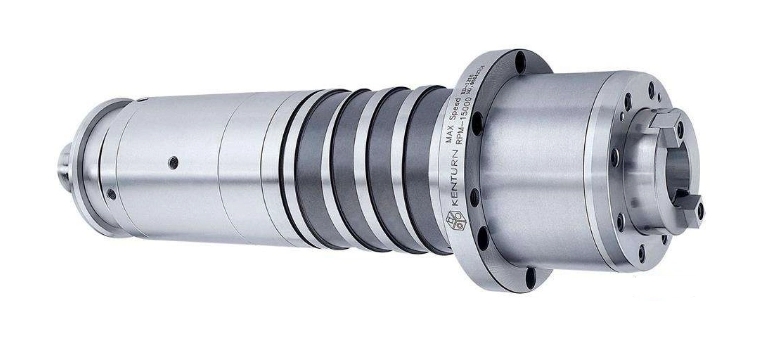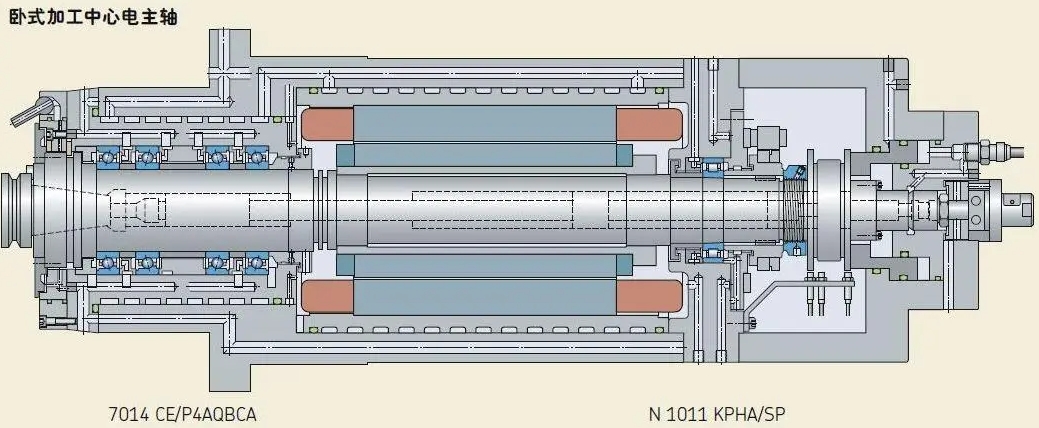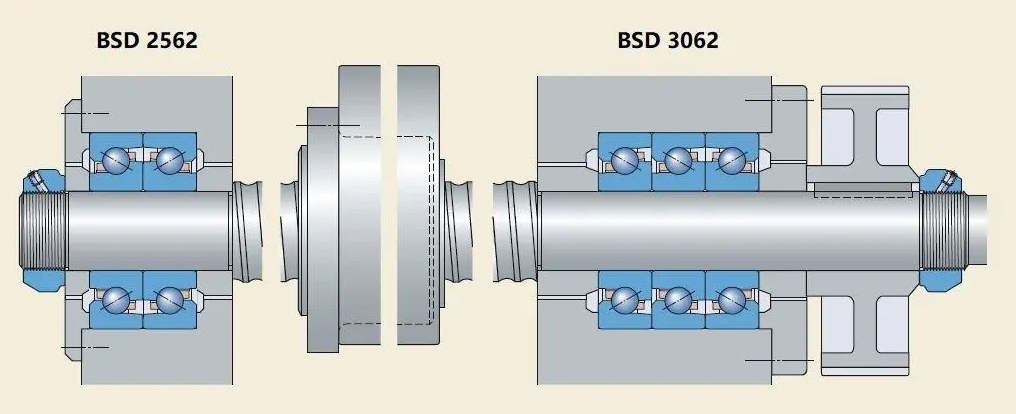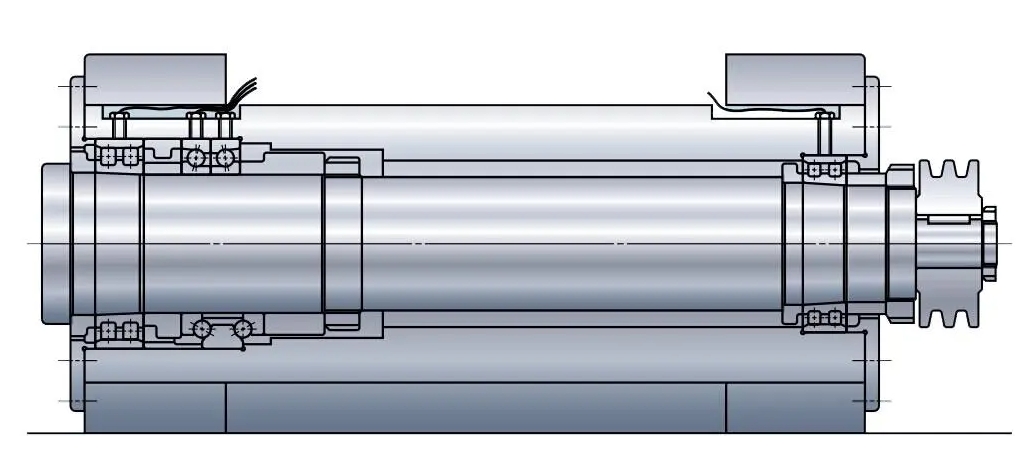Not so long ago, a typical automotive engine factory had to maintain many machines, each dedicated to a specific need. This group of specialized machines were configured together into a transfer line along which the original workpiece would be moved backwards. Moving, each machine performs a series of milling, drilling or tapping operations, ultimately transforming it into a finished product. In each of these machines, the spindle bearings are optimized for its specific duty cycle.
Times have changed and transfer lines have been replaced by flexible CNC machining centers to improve efficiency, achieve smaller volumes and more frequent product changes. CNC machines range from three to nine (usually five) axes, using Automatic tool changers, tool magazines, carousels and robotic workpiece material handling systems to perform multiple operations, reduce cycle times and help drive efficient operations on factory floors around the world.
But in the world of machining, different tasks have different requirements, and many of these different operations and materials have completely opposite requirements for the milling spindle, as well as the milling spindle bearings. Materials may range from traditional high-alloy steels and cast irons to aluminum, titanium and nickel alloys, with the material as well as the cutting operation determining the loads and speeds that must be applied, with further effects on the bearings.
Few individual components can affect overall performance as profoundly as milling spindle bearings. Bearings determine speed, load-carrying capacity, accuracy and stiffness. During operation, bearings will affect the operating temperature, vibration and noise of the spindle. Machine tools must be very precise, Reliable and capable of high levels of productivity.
Optimizing performance depends largely on selecting the right bearing for the right machining application. Whether you are a machine tool spindle designer at an OEM, or a maintenance, repair and overhaul shop, the needs of the end-use application are critical when selecting bearings. important.

Comparing the needs of different jobs, speeds, loads, and other factors can vary dramatically in a given machining application. Finish cuts are used to produce superior surface finishes with minimal chatter, while rough cuts are used in the shortest amount of time. Remove the most material within.
Finishing cuts are shallow and precise, with small tool diameters, high spindle speeds, and low feed rates (the linear speed of the tool through the workpiece). Therefore, they produce low tool loads but require the spindle to operate at very high speeds. Running well.
Roughing cuts are deep and wide, with large-diameter tools running at very high feed rates at relatively slow spindle speeds, resulting in significantly higher loads on the tools supported by the spindle bearings.

Each of the different conditions mentioned above places unique demands on the milling spindle bearing itself, considering that the needs of roughing and finishing are opposite and require different bearing performance (low speed/high load vs. high speed/low load), As speed increases, the centrifugal force on each ball within the spindle bearing also increases.
This centrifugal force acts radially away from the center of rotation of the bearing (assuming a rotating reference frame). The outer raceway prevents the balls from being thrown out of the bearing. As the centrifugal force increases, the contact stress between the raceway and the balls increases. The increased centrifugal force also pushes the point of contact of each ball with the outer raceway toward the bottom of the raceway.
However, the exact opposite happens between the ball and the inner raceway, causing the inner and outer contact angles to be unequal. This phenomenon is called a contact angle shift. Because the ball is a solid, it can only have one axis of rotation, so An increase in contact angle offset results in sliding, greater heat generation, higher operating temperatures and increased ball surface wear.

One way to minimize the effect of increased centrifugal force is to simply reduce the weight of the ball. There are two ways to do this. One is to reduce the size of the ball. The other is to use ceramic balls. Ceramic balls are 40 times lighter than steel balls. %. The lighter ball produces a lower centrifugal force that cannot fully offset the higher contact stress caused by the higher elastic modulus of the ceramic. However, the lower centrifugal force reduces the contact angle shift and thus reduces the stress caused by sliding. Heat is generated.
The second method is to increase the raceway radius. The relationship between the raceway radius and the ball diameter is called the raceway curvature and is mathematically described as the raceway radius divided by the ball diameter, expressed as a percentage. For example, if the raceway If the radius is 0.5 mm and the ball diameter is 1 mm, the raceway curvature is 50%. A 50% raceway curvature means line to line contact and the bearing will not rotate freely, so the curvature is always greater than 50%.
Curvatures below 54% are considered closed, while greater curvatures are considered open. Bearings with closed curvature are better at carrying loads but generate more heat, while open bearings run faster. But the capacity is reduced.

Using either of these two measures to increase the bearing's rotational speed will significantly reduce the bearing's load-carrying capacity, thereby reducing the spindle's rough cutting ability. Typically, there are two or three designs available for a given ISO size series. Options, these designs incorporate various sphere sizes and curvatures to optimize performance for specific cutting profiles.
This is why it is important to consider the expected duty cycle of the machine so that the best bearing design and ball material can be selected, some examples are below.
Spindles designed for heavy tool loads should have bearings with the largest steel balls that will fit in the bearing cross-section (>50% of the bearing cross-section) and a closed raceway curvature to reduce contact stresses between the raceway and the balls . The large ball diameter and closed curvature lend themselves to the heavy loads and slower speeds associated with roughing, which may range between 500rpm and 1500rpm, depending on tool diameter, material removal rate and workpiece material. Most roughing spindles use grease as the lubrication method and have a rated speed of 3500 rpm to 7500 rpm depending on the machine size.
When selecting bearings for higher speed spindles designed for dedicated finishing cuts, minimizing heat generation should be the guiding principle, and the large ball/closed curvature bearings described above become less than ideal due to the excessive heat generation inherent in the design. . Choosing a small ball design with open curvature (<50% of the bearing cross section) will generate less heat. High-speed finishing spindles operate between 7,500 rpm and 24,000 rpm and use metered air/oil as the lubrication method. Dedicated roughing spindles are typically rated from 15,000 rpm to 30,000 rpm, depending on machine size. /minute.
If the design goal is for the spindle to be capable of both heavy cutting at lower speeds and fine cutting at higher speeds, then bearings must be selected that meet these opposing demands. These needs, and everything in between, are very common for vertical machining centers. Designers should seek a precision bearing with balancing capabilities to bridge this gap. Bearings with a medium ball design (approximately 50% of the bearing cross-section) with moderate open curvature will produce lower heat generation and good load-carrying capacity. Mills required to perform roughing and finishing operations operate at speeds as low as 500 rpm and as high as 12,500 rpm. And use grease or metered air/oil as the lubrication method. Multipurpose spindles are typically rated from 7,500 rpm to 15,000 rpm, depending on machine size.

Ceramic balls are often chosen when the spindle's duty cycle is dominated by high-speed finishing operations. In addition to their lower density/weight, ceramic balls have a higher elastic modulus than steel balls, resulting in a smaller contact ellipse (the contact area between the raceways caused by the elastic deformation of the ball and ring). shape). The smaller the contact area, the higher the contact stress between the ball and raceway under the same load. If external loads do not create excessive stress between the balls and raceways, the bearing will generate less heat due to the smaller contact area.





